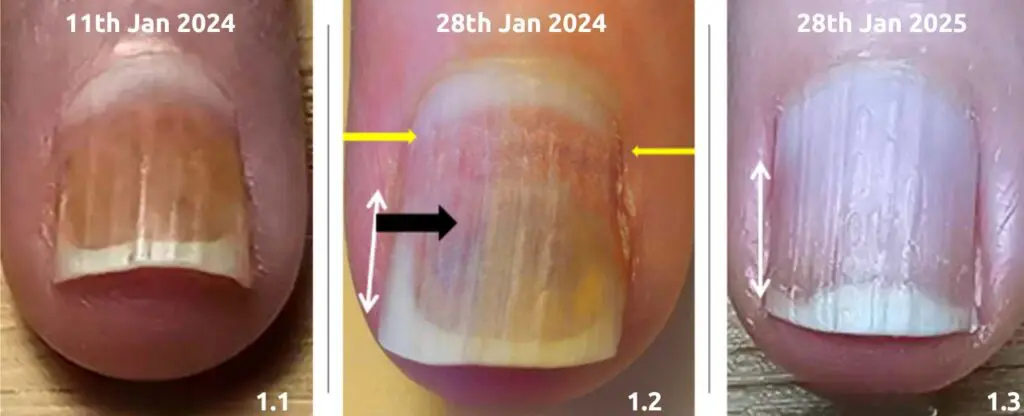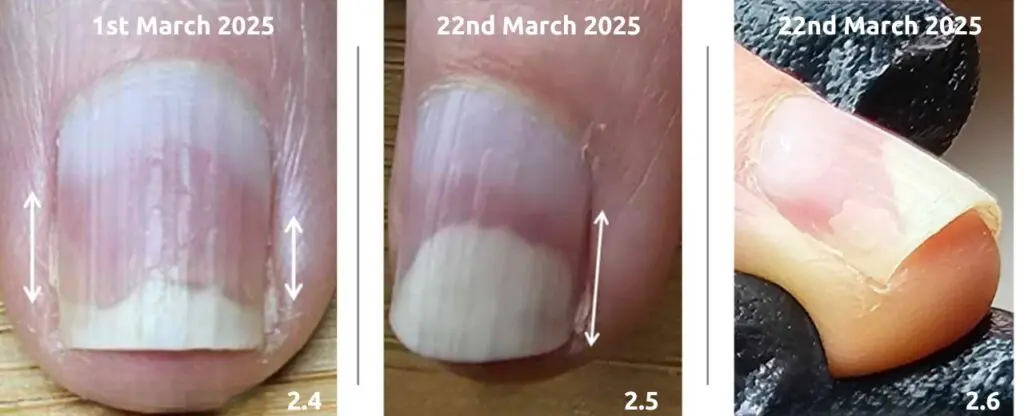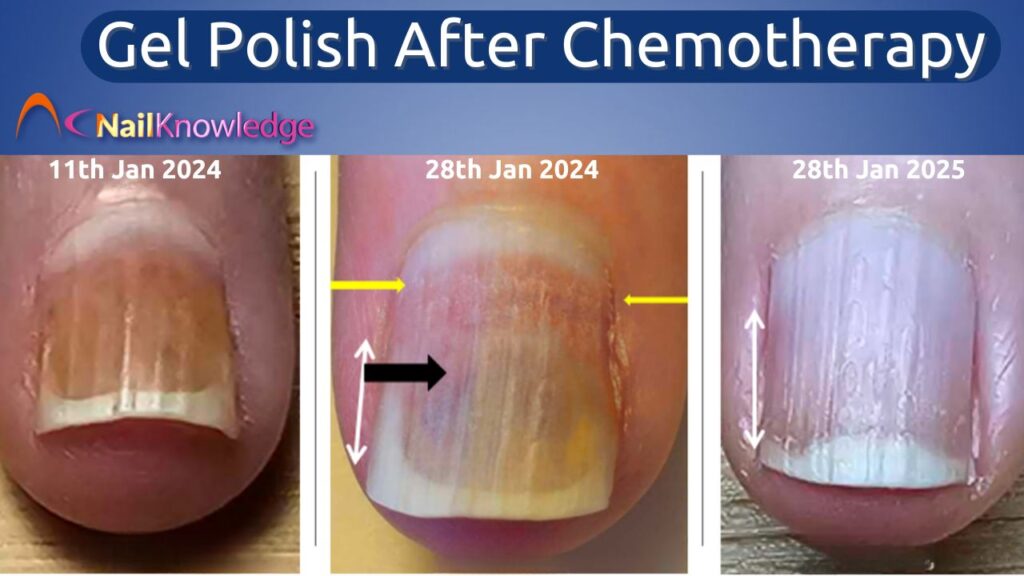Khi nào thì an toàn để làm móng tay lại?
Chemotherapy is a battle, a test of resilience, and for many, a transformative journey. But alongside its life-saving power, it takes a toll on the body, and nails are no exception. Brittle, ridged, discoloured, or even lifting from the nail bed, these are common post-chemo concerns. And now that the treatment is over, a question arises: when is it safe to indulge in a little self-care and wear gel polish after chemotherapy? Let’s break it down.
Understanding Chemo’s Impact on Nails
Your nails are like a reflection of what’s happening inside your body. Chemotherapy doesn’t just attack cancer cells, it affects fast-growing cells everywhere, including those responsible for nail growth. That’s why many people notice their nails becoming weak, peeling, or developing dark streaks during treatment.
Some chemo drugs are harsher on nails than others. Taxanes, for example, are notorious for causing nail damage. In some cases, nails may even separate from the nail bed (a condition called onycholysis), it’s also possible that chemotherapy toxins in the blood leak from the nail bed where the weakest blood capillaries are and that’s not only extremely painful its dangerous for the nail tech. Given all this, it’s understandable why doctors often advise against wearing sơn gel during treatment, your nails need to be carefully monitored especially for color changes – and need be, given time to heal. Not doing so is plain foolish!
Tại sao nền móng tay đặc biệt dễ bị tổn thương trong quá trình hóa trị

1-1: Leakage of chemotherapy through the capillaries of the nail bed.-2: Start of healing process the nail bed is still irritated and the nail plate is being forced out of the paronychium cup due to oedema.
1-3: Almost full recovery of the nail bed – where the little white arrow is the nail bed is still showing signs of irritation.
When nailbeds are affected by leakage of chemotherapy because the blood capillary’s get damaged, the recovery of those capillary’s can be a long, hard, ugly road and nail hygiene is paramount to stop any secondary infections from taking place. When oedema forces the nail plate out of the paronychium cup the worst thing you can do is apply any or all artificial nail products, the nail plate needs to be handled in such a way that the nail plate remains flexible and if need be a non-stick dressing (soft foam bandage) can be applied to stabilize the nail plate. Patients can also experience neuropathic symptoms that can be excruciating and again DO NOT do anything to the nails apart from good nail hygiene and maintenance and keep the free edge short.
Móng tay sau khi hóa trị: Tại sao quá trình phục hồi của mỗi người lại khác nhau
But post-treatment? That’s when things get a little tricky. While the urge to get back to normal is strong, patience is key when it comes to your nail health.

2-4: 14 months after the end of chemotherapy – the nail bed starts to show signs of irritation and onycholysis.
2-5: 14 months and 21 days later, onycholysis is extreme and client is experiencing pain where the nail bed is red, there are no signs of hyperkeratosis or blood splinters – just clear clean detachment of the nail plate from the nail bed.
2-6: Although at the right lateral nail wall of this same finger it ‘looks like‘ it could be a blister, there are no signs of blistering, hyperkeratosis or extreme desquamation of nail bed cells when we look down the barrel of the nail.
We tested these nails for fungi or Candida, these tests were negative. Client does not use any nail coatings and is almost obsessive about hand and nail care. There is no conceivable reason from the outside for this nail plate detachment – None, but … something is happening and because of this clients medical history we have referred her back to the Oncologist and Dermatologist.
When Nail Recovery Doesn’t Go as Expected
With all our knowledge we cannot find a conceivable reason for this sudden nail bed irritation and onycholysis – if you don’t have this knowledge and your client just wants pretty nails you MUST refuse service – you will not be insured for any or all damage that may or may not be caused by applying any or all artificial nail products.
It Ain’t Over Till It’s Over
Sometimes nails need more time. After your immune system has been broken down by chemo or immune therapy, the slightest little thing can affect the nail unit. Do not use any artificial nail products on nails showing any onycholysis or nail wall separation. Let the specialists that the client is still seeing find the cause and wait, your client will thank you for it.
Its tough, your client has survived the hell that is cancer, he/she lost all her hair, her body swelled in all directions, her nail plates were hanging off, her operations were hard, the scars visible – he/she got through all of that and all he/she wants is to be ‘normal’ to look good, to get on with his/her life – how much harm can pretty nails cause?
We spent 14 months fighting to hold on to these nail plates – if we do something now that compromises them in the name of beauty and this client would get a secondary fungal or bacterial infection she could still lose her fingers – That’s not what were here for – we are educated nail techs, nothing more and nothing less.
The problem is every client is different – There is one guarantee ***Không phải tất cả cơ thể đều phản ứng giống nhau với cùng một liệu pháp và không phải tất cả liệu pháp đều phản ứng giống nhau ở những cơ thể khác nhau***
Việc chăm sóc móng trong và sau khi hóa trị chỉ nên giới hạn ở việc làm móng đơn giản, thụ động và không xâm lấn.
Some people don’t suffer too much, others almost loose their minds because the neuropathic pain in their nail units is unbearable.
Quy tắc số 1: KHÔNG GÂY HẠI
- If you don’t know what your doing – don’t do it
- If you’re not sure you should do it – don’t do it
- If you’re worried about doing it – don’t do it
- If your client says – its ok, my oncologist said its fine without a letter of approval – don’t do it
- If your clients oncologist says a passive manicure is ok with a letter of approval and you want to grab your efile with a safety bit – don’t do it
Khi nào bạn có thể bắt đầu sơn gel trở lại?
There’s no universal rule for when you can safely start using sơn gel sau khi hóa trị, nhưng hầu hết các chuyên gia khuyên bạn nên đợi ít nhất ba đến sáu tháng sau lần điều trị cuối cùng của bạn. Tại sao? Bởi vì mặc dù hóa trị đã ra khỏi hệ thống của bạn, tác động của nó vẫn còn kéo dài. Móng tay của bạn vẫn còn mỏng manh và nhạy cảm hơn, việc sơn gel quá sớm có thể gây ra tổn thương không mong muốn.
For some, nails bounce back fairly quickly. Others may take a year or more to fully regain strength. A good rule of thumb? If your nails still feel weak, thin, or ridged, it’s best to hold off. Let your (clients) body recover first before exposing your (clients) nails to gel polish application and removal.
Cách để biết móng tay của bạn đã sẵn sàng chưa
Trước khi tiếp tục sơn gel, hãy kiểm tra những dấu hiệu sau:
- Sức mạnh – Can your nails withstand gentle pressure without bending or splitting?
- Không có sự tách biệt – Is the nail firmly attached to the nail bed with no separation?
- Không nâng từ các bức tường bên – if the nails are not in the paronychium cup do not use any artificial nail products.
- Màu sắc khỏe mạnh – Have any dark streaks, yellowing, or discolouration faded?
- Không có gờ hoặc bong tróc quá mức – Are your nails strong enough to hold polish without it chipping quickly?
If you’re still seeing signs of damage, don’t rush. Instead, focus on strengthening và hoặc cải thiện Đầu tiên là móng tay của bạn.
Chuẩn bị móng tay để sơn gel sau khi hóa trị
If you’re confident that your nails are ready, taking the right precautions will help you avoid setbacks. Here’s what you should keep in mind:
1. Sự ngậm nước là không thể thương lượng
Móng tay sau khi hóa trị rất khát nước. Hãy giữ cho móng tay ngậm nước bằng một loại dầu biểu bì. Dehydrated nails are more prone to peeling and snapping, chemotherapy or immunotherapy can cause nail plates to become thinner or more brittle, so this step is crucial. There are some amazing products in the market anno 2025 – something containing 10% Urea is perfect as are all high quality nail & skin oils, avoid oils and or lotions with artificial colourings or perfume as your client may well be more sensitive to irritations until he/she is fully recovered.
2. Avoid Buffing
Nói về việc đánh bóng. Móng tay của bạn đã mỏng sau khi hóa trị, và việc đánh bóng sẽ khiến chúng yếu hơn nữa. Không đánh bóng móng tay trước hoặc sau khi hóa trị hoặc liệu pháp miễn dịch.
3. Hãy chú ý đến việc loại bỏ
Gel polish removal can be harsh on delicate nails. Acetone soaks can dry out the nail plate, leading to further brittleness. Instead of soaking for long periods, use a gentle removal method with foil wraps and plenty of high quality nail & skin oil afterwards.
Các lựa chọn thay thế cho sơn gel trong khi móng tay của bạn đang phục hồi
If your nails aren’t quite ready for gel but you still want a polished look, consider these alternatives:
- Tăng cường điều trị – Products with keratin or biotin can help rebuild nail strength without the risk of damage from gel. IBX is a real option if used as advised and only after professional training.
- Bọc móng tay – These provide colour and durability without the need for UV curing or harsh removal processes. Nail Wraps can be totally gorgeous and if used properly will cause no damage take special care to remove them properly.
- Nail Polish or Nail Varnish – take the time to apply it well, use a new base coat and it can last for days but if it doesn’t you can remove it with a good nail polish remover or acetone – this is important, by any or all signs of change in the health of the nail plate or nail bed we need to see whats going on asap.
Khi nào cần tìm lời khuyên chuyên nghiệp
If your nails remain weak, discoloured, or painful long after finishing chemo, it may be worth consulting a dermatologist or an Oncology Hand Care Specialist. In some cases, nail damage can be a sign of an underlying issue, such as persistent inflammation or a fungal infection. Actually post chemotherapy you are more susceptible to fungal infections especially White Superficial Onychomycosis and Candida.
Suy nghĩ cuối cùng: Đón nhận cuộc hành trình
Getting back to normal after chemo is a process, and that includes nail care. While the temptation to dive straight back into gel polish after chemotherapy is understandable, patience is the name of the game. Give your nails the time they need to recover, nourish them with care, and when they’re ready, enjoy that well-earned manicure with confidence.
After everything you’ve been through, your nails deserve just as much care and attention as the rest of you. Take it slow, listen to your body, and when the time is right, you’ll be back to flaunting those perfectly polished nails in no time.


